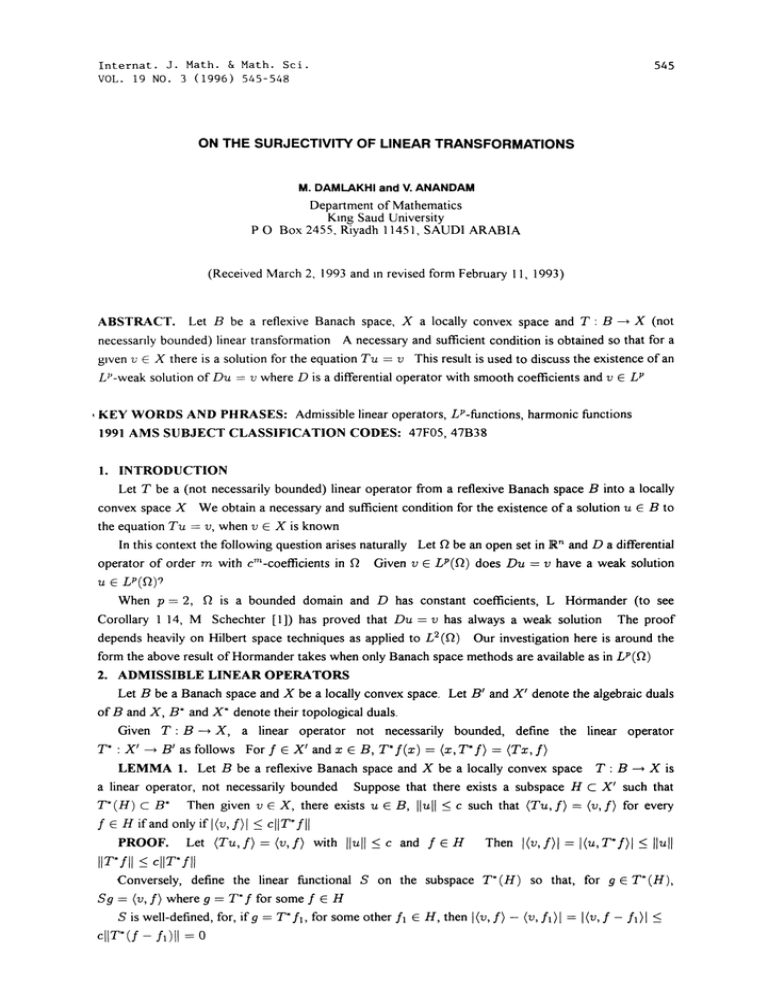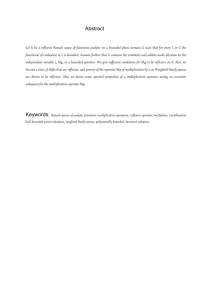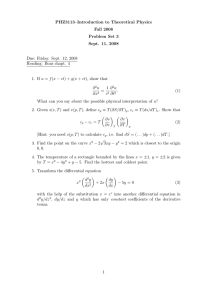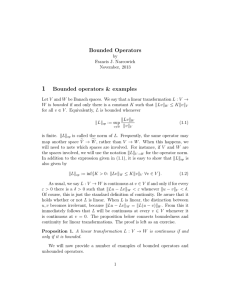Document 10447306
advertisement

Internat. J. Math. & Math. Sci. VOL. 19 NO. 3 (1996) 545-548 545 ON THE SURJECTIVITY OF LINEAR TRANSFORMATIONS M. DAMLAKHI and V. ANANDAM Department of Mathematics Kng Saud University P O Box 2455, Riyadh 11451, SAUDI ARABIA (Received March 2, 1993 and n revised form February 11, 1993) ABSTRACT. Let B be a reflexive Banach space, X a locally convex space and T: B X (not necessarily bounded) linear transformation A necessary and sufficient condition is obtained so that for a gven v X there is a solution for the equation Tu v This result is used to discuss the existence of an L’-weak solution of Du v where D is a differential operator with smooth coefficients and v E L ’ KEY WORDS AND PHRASES: Admissible linear operators, L’-functions, harmonic functions 1991 AMS SUBJECT CLASSIFICATION CODES: 47F05, 47B38 1. INTRODUCTION Let T be a (not necessarily bounded) linear operator from a reflexive Banach space B into a locally convex space X We obtain a necessary and sufficient condition for the existence of a solution u B to the equation Tu v, when v X is known In this context the following question arises naturally Let f2 be an open set in/R and D a differential operator of order m with c"-coefficients in f2 Given v E LP(f2) does Du --v have a weak solution L() When p 2, f is a bounded domain and D has constant coefficients, L H6rmander (to see Corollary 14, M Schechter [1 ]) has proved that Du v has always a weak solution The proof depends heavily on Hilbert space techniques as applied to L(f) Our investigation here is around the form the above result of Hormander takes when only Banach space methods are available as in LP(f) 2. ADMISSIBLE LINEAR OPERATORS Let/3 be a Banach space and X be a locally convex space. Let/3’ and X’ denote the algebraic duals of/3 and X, B* and X* denote their topological duals. Given T:/3 X, a linear operator not necessarily bounded, define the linear operator T* :X’ B’ as follows For f X’ and:r, B, T*f(z) (:r,,T’f) (T:r.,f) LEMMA 1. Let/3 be a reflexive Banach space and X be a locally convex space T: B X is - a linear operator, not necessarily bounded Suppose that there exists a subspace T*(H) c B* Then given v X, there exists u B, Ilull < c such that (Tu, f) f H if and only if [(v, f) < tilT* PROOF. Let (Tu, f)= (v, f) with I111 _< c and f H H c X’ such that (v, f) for every Then IIT*fll -< cllT* $9 Conversely, define the linear functional S on the subspace T*(H) so that, for 9 T’(H), (v, f) where 9 T*f for some f H S is well-defined, for, if 9 T* fl, for some other fl H, then [(v, f) (v, fl)[ I(v, f Y)l _< tilT* (f fl)[I 0 5/46 M I)AMI,AKlll ANI)V ANANI)AM It s clear that S is a bounded linear functional on the subspace T’(H) c B" with [[S[[ <_ c and hence by Hahn-Banach theorem extends as a bounded linear functional on B’, preserving the norm This implies, since B s reflexive, that there exists u E B such that for every h E B’, (u, h) Sh and [lull I[Sll c In particular, fh T f f H, we have (u,T" f) S(T" f) (v, f) Thus, for any f E H, (v, f) (u, T’f) This completes the proof of the lemma REMARK 2.1. The above lemma is inspired from section 16 of M Schechter [1] where the existence of a weak solution of a differential operator in the Hilbert space L’-’ () is investigated DEFINITION 2.1. Let /3 be a Banach space and X be a locally convex space A linear operator TB X, is said to be admissible if there exists a weak* dense subspace M c X" such that T’(M) cB" PROPOSITION 2.1. Let B be a Banach space and X be a Fr6chet space Let T"/3 X be a linear operator Then T is continuous if and only if T is admissible PROOF. If T is continuous, then for any f E X* clearly T*f B* and hence T is admissible Conversely, let T be admissible with T* (M) C/3* where M is a weak*-dense subspace of X" We will prove that T is continuous by showing that T is closed (W Rudin [2], p 50) Let x, B be a sequence such that lim,z, z and lim,Tz, y Then for any f M, (x,, T" f) (Tx,, f) Taking limits (x, T’f) (y,f) which implies that (Tx, f) (y, f) for every f Mand consequently (Tx, h) (y, h) for every h X*, since M is W*-dense in This implies that Tx y since X* separates X, that is, T is closed THEOREM 2.1. Let B be a reflexive Banach space and X be a locally convex space Let T B X be an admissible linear operator with T* (M) C B* Then, for any given v E X there exists u E B such that [[u[[ _< c and Tu v ifand only if [(v, f)[ _< c[[T*f[[ for every f U PROOF. In view of Lemma (where we take H M), it is enough to prove that the condition (Tu, f) (v, f) for every f M is equivalent to the fact that Tu v Now, the condition above is equivalent to the fact (Tu, h) (v, h) for every h X*, since M is dense in X* with its W*-topology Since X* separates points on the locally convex space X, the latter condition is equivalent to the fact Tu :v 3. WEAK SOLUTIONS IN LP() Let fl be a domain in ’, n k 1. Let A ak(x)D ’ be a differential operator of order m, with ak(x) E cm(l) Let A* denote the adjoint operator Let 1 < p _< oo and !+!:1 , TIIEOREM 3.1. With the above assumptions on A and p, let f E LP() be given Then there exists a weak solution of Au f, u G L’(fl) and Ilu[l, <_ c if and only if I(, f)[ <- c[IA*[Iq for all c(a) Lp and Au f has a weak solution u L () and g LP(), (, g) f-(x)(x)dx PROOF. Suppose f Define, for E c , Ilull _< c _< Then, I(. f)l- I(. A)I- I(A*.)I _< I1=11, Conversely, define the linear functional S on the subspace A" (c (f)) such that S (A* ) IIA*II IIA*II (, .f) Then, as in Lemma 1, S is a well-defined linear functional on A*(c(Y)) C Lq() with IISII _< c and hence extends as a continuous linear functional on Lq(fl), so that there exists u LP(fl) satisfying the condition S(v) (v,u) for all v A*(c()) and Ilullp -IISII _< c )N 11 I1. SIJR.Ii:C 11VI In pamcular, for any solution of Au E c d" 1Y ()1. I.INI.IAR 11ANSI.’()RMA I’R)NS (), (, f) S(A’’) (A’,u)- (,Au) 5Z7 Hence u is a weak f THEOREM 3.2. Let f L,,, () Then there exists a bounded weak solution u of the equation Au f fand only if[ J-](z)(x)dx[ <_ CI A’ tbr every c0 () PROOF. In view of the above theorem, we will give here only a few details of the proof On A’(q (92)), considered as a subspace of L(f), define the linear functional S such that S(A’)- (,f) fedx Then S extends as a bounded linear functional on L(f2) so that there L () such that Sg (g, u) for every g L (f) exists u This leads to the fact that u is a weak solution of Au f In the context of the above theorem where we were looking for a bounded weak solution of a dfferential equation, the following proposition concerning the bounded solutions of the Laplacian in , s of interest PROPOSITION 3.1. Let f C6"’(" ), having compact c (’) such that Au > 3, there always exists a bounded u solution exists if and only if fK f(x)d:r n PROOF. Since some u E c /’x s an support K, be given in ]R" Then, if or 2, such a bounded c f, if n 0 elliptic differential operator with constant coefficients, there always exists f Here we are looking for a bounded function u in c (") such that/u Let Ix E,(x) log Ix[ 1 ]’x"- if n= 1 if n 2 if n>3 Now, using the results in [2], we can show that for a fixed y E K and any x u(x) (/ f(x)dx)fiE,(x- K , y) 4-l(x) where l(x) is a bounded harmonic function in K ifn _> 2 (and affine bounded ifn and/3,- (,_), if n _> 3, Here/3 1/2, 1) Consequently, using the fact that E, (x) is bounded in a neighborhood of the point at infinity if and only if n > 3, we arrive at the conclusion of the proposition NOTE. Since a bounded harmonic function outside a compact set in JR", n > 2, tends to a limit at infinity, if u is a bounded solution of/X,u f c’, we can choose u0 c (I) so that u0 tends to 0 at infinity and satisfies the condition ,u0 f In this case, u0 is unique 4. SURJECTIVITY ON TIlE SOBOLEV SPACES We conclude this article with a remark on the solutions of a differential operator on the Sobolev spaces H (JR’) We make use of the following properties. i) For each real s, H (JR’) is a Hilbert space such that H ii) H is the completion of c’ in the norm iii) For any s, H represents the topological dual of H iv) If s > + k where k is a nonnegative integer, then H c c v) If A is a differential operator of order m with c’-coefficients, A* (c’) c L C H for any s >_ 0 vi) If A is a differential operator of order m with c-coefficients, A* (c) C H Then, with arguments similar to those utilized to prove some of the earlier results, we obtain 58 M I)AMI,AKIII ANI)V ANANDAM THEOREM 4.1. Let T be a distribution in JR", r > Suppose that A is a differential operator of order rn satisfying one of the following two sets of assumptions a) A has c’"-coefficients and s > 0 b) A has c -coefficients and s is any real number Then T Au in the sense of distribution, for some u E H if and only if IT()I < cllA’lljt, for all q5 5 q;" REMARK 4.1. Let A be a differential operator of order m with coefficients either constants or from the Schwartz’s space (i e rapidly decreasing c’-functions) Then iflT(q)l < cllZ’4lln, for all c0’, we have as in the above theorem, T Au, u H and consequently, if s > 7 + m, then T A u in the classical But, in this special case, T H sense e u is a strong solution of the differential equation Hk(f/)-spaces Let now f/ be an open set in ]R’,r > 1 Recall that for any positive integer H0(f2) is defined as the closure ofc’(f/) in Hk(f/) For any v L(f2), define Ilvll_ sup , Then, if H -k() denotes the completion of L () in the norm ]]_k, () is the topological dual of k for 0 -Gwaiz any integer (see [4], p 191) H() With this background, we can state an analogue of Theorem 4 as follows THEOM 4.2. Let T be a distribution in an open set in S 1 Suppose A is a linear dffercntial operator with c ()-coecicnts Then, for y integer k 0, there exists u @ H-k() sch that Au T if and only if]Tl cllA*lln<) fo all @ c() , REFERENCES [] [2] [3] [4] SCHECHTER, M, Modern Methods m Parttal Differential Equattons, McGraw-Hill Inc, 1977 RUDIN, W, Funcltonal Analysts, McGraw-Hill Inc, 1973. ANANDAM, V., Espaces harmoniques sans potentiel positif, Ann. Inst. Fourier 22 (1972), 97-160 AL-GWAIZ, M, Theory of Distributions, Marcel Deker Inc., New York, 1992







